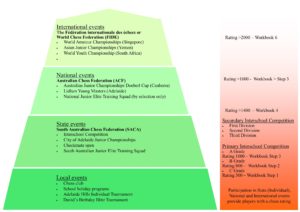When you play chess in tournaments you start gaining a rating. Each country has their own rating database, in Australia this is maintained by the Australian Chess Federation (ACF) and once you have played internationally you will also obtain a FIDE (World Chess Organisation) rating.
There are 2 types of ratings available:
Rapid Rating; which you obtain for playing in tournaments with games that are less than 60 minutes per player.
Classic Rating; which you obtain for playing in tournaments with games that are more than 60 minutes per player.
Australian ratings are registered and monitored by the Australian Chess Federation and will start approximately at 500. Your rating will move up or down depending on your wins and losses and of course whether you have been playing a higher or lower rated player.
To compare ratings with the Step-by-Step method; if a students has completed Step one, they would have a comparab le FIDE rating of 500. Step two will be a rating of 800, Step 3 – 1000, Step 4 – 1400, Step 5 – 1600 and Step 6 – 2000+
If a student wanted to develop using the Step-by-Step method, the workbooks relate as follows; C Grade – Step 1, B Grade – Step 2, A Grade – Step 3, Secondary Division – Step 4 and National and International – Step 5 and 6.
Check out the latest Australian Chess Federation’s Ratings HERE
The FIDE Elo rating system uses statistical formulas to measure the chess skill of a player by calculating the relative skill levels of players in a game. The creator, Arpad Elo, a Hungarian-born American physics professor, was a master-level chess player himself. The system has improved so much so that Elo rating can predict the outcomes of chess games with high consistency and reliability. For example, if player A has an Elo rating 245 points more than player B, the chances are player A will score 4 out of 5 points against player B. If the difference in rating is 200 points, the score is reduced to 3 out of 4 points. This reliability of prediction is a result of a very reliable rating system.
If a junior player who had a rating of 1010 before chess coaching and improved his rating to 1443 after three months of training, it allow chess coaches and players to measure and monitor the effectiveness of their training programs.
How to get a chess rating?
For FIDE rating, refer to the World Chess Federation (FIDE) Rating Regulations at http://www.fide.com/component/handbook/?id=161&view=article
For ACF rating, ACF uses the Glicko system, which is different in terms of the formula used. The Glicko system can be found at http://en.wikipedia.org/wiki/Glicko_rating_system or – The Glicko System by Professor Mark Glickman, Boston University
How to calculate rating?
For FIDE rating, refer to http://ratings.fide.com/calculators.phtml
For ACF rating, refer to Glicko calculator at http://www.glicko.net/glicko.html
Chess Pyramid
Always wanted to know what the structure of Australian chess is like? Can you work out where in the pyramid you are and where you want to go?

Becoming a Grandmaster in chess
We all know that the best of the best in the world of chess battle it out around the world. But how do you become part of the best and how do you become a Master and Grandmaster?
When students play regularly in South Australia, they can attempt competing in the State or National Championships. These are organised by the Australian Chess Federation (ACF).
At this level there is the opportunity to train with some of the best of Australia and the hard work can be rewarded with a place in the Junior Elite Training Squat, also known as the JETS. 30 students get coached in this Elite training to play in International Tournaments organised by the World Chess Organisation (FIDE). If you play for Australia in International competitions – you will play as part of the Chessaroos!
Taking the final leap
To become a Master you will need to earn three master titles in a period of five years. Playing in different international tournaments will lead to different qualifications for the master titles. You can become a FIDE master (FM) and then an International Master (IM). Australia has 8 Grand Masters; Anton Smirnof obtained his title in 2017
Once you are a master you can become a Grandmaster by qualifying in a similar way, winning three Grandmaster titles in five years and having a minimum rating of 2500. Once you have this title it is for life and is often abbreviated as GM.
